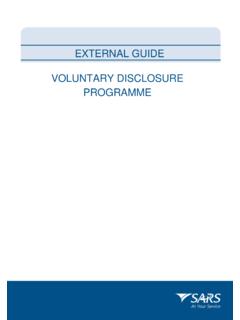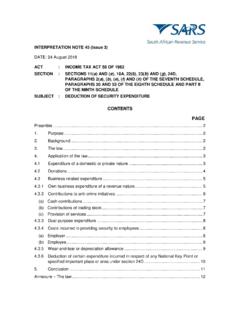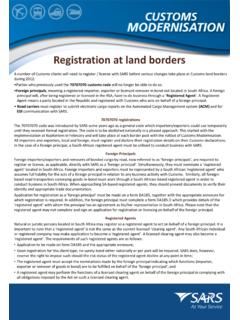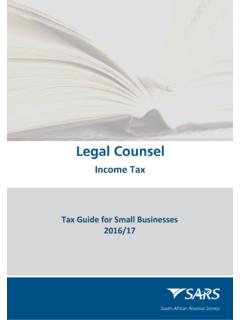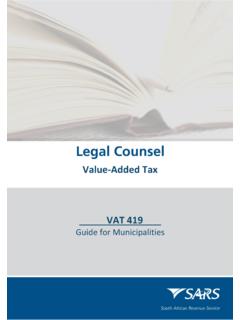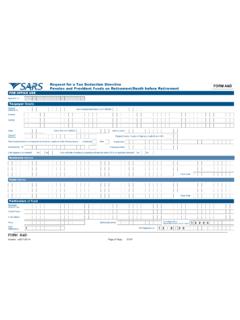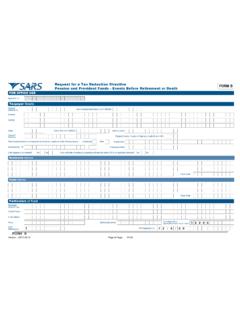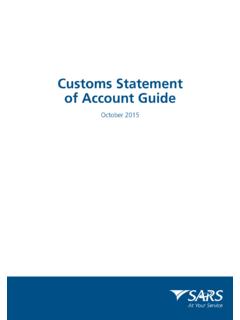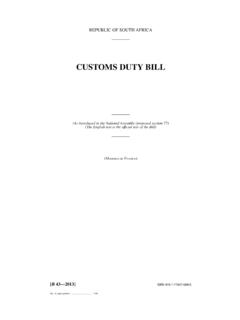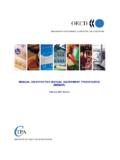Transcription of SECTION 31 OF THE INCOME TAX ACT, 1962 (the Act ...
1 REPUBLIC OF SOUTH AFRICASOUTH AFRICAN REVENUE SERVICEPRACTICE NOTE NO. 7 DATE: 6 August 1999 SECTION 31 OF THE INCOME TAX ACT, 1962 (the Act) :DETERMINATION OF THE TAXABLE INCOME OF CERTAINPERSONS FROM INTERNATIONAL TRANSACTIONS : transfer PRICINGISSUED BY THECOMMISSIONER FOR THE SOUTH AFRICAN REVENUE SERVICE1 AcknowledgementThe kind assistance of the Policy Advice Division of the Inland Revenue Department in New Zealand,in permitting the use of material published by the Department, is gratefully DEFINITIONS AND THE COMMISSIONER S APPROACH TO THE PRACTICE SECTION 31 OF THE FINANCIAL TAX THE ARM S LENGTH PRINCIPLES OF ACCEPTABLE METHODS FOR DETERMINING AN ARM S LENGTH PRACTICAL 2412. THE COMMISSIONER S APPROACH TO transfer pricing REVIEWS, AUDITS 3113. INTEREST AND SECONDARY TAX ON COMPANIES (STC).
2 3315. BURDEN OF 3316. ADVANCE pricing AGREEMENTS (APA S)..3317. INTANGIBLE INTRA-GROUP COST CONTRIBUTION EFFECTIVE 3421. 34 ANNEXURE A : CHARACTERISTICS OF A FUNCTIONAL 35 ANNEXURE B : THE FOUR-STEP APPROACH .. and The concepts below are defined in SECTION 1 and SECTION 31 of the Goods; Services; International agreement;The concept of managed or controlled is used a number of times in the definition and thescope thereof is intended to be wider than the term managed and controlled , as used inother sections of the order to determine the place where an entity is managed or controlled, regard will be had tothe business activities of the entity and business activities of connected persons, as well asthe degree of autonomy under which the entity s view is that the control of an entity is to be found at the meeting place of the personswho exercise authority over and control direction of the entity s business operations .
3 Acompany is generally controlled by its directors. However, situations may be encounteredwhere control is effectively exercised by the directors of a company s holding company orultimate holding company. The question of where the shareholders may reside or meet inannual general meeting (in the case of a company) is therefore place where directors and other persons performing the same functions (in the case ofentities other than companies) usually exercise their functions and direct the affairs of theentity, is an indication of where an entity is controlled. In most cases this will be the placewhere the entity s head office is place where an entity is managed is usually the place where the day-to-day running ofthe business activities takes the above it is evident that the place from which an entity is controlled is not necessarilythe place from which it is Connected connected person is defined in relation to each of the following categories of In relation to a natural person:(i)any relative of such person (including by adoption), children and parents,grandchildren, grandparents, brothers and sisters, great-grandchildren, great-grandparents, uncles and aunts, nephews and nieces, the person s spouse and anyperson who is a relative of the spouse, the spouse of any of the above-mentionedrelatives.
4 And(ii) any trust of which such natural person or any relative or spouse referred to above is abeneficiary. A beneficiary means any person named, in the will, trust deed or letter ofwishes, as a beneficiary or as a person upon whom the trustee or the trust has apower to confer a benefit from the In relation to a trust:(i)any beneficiary of such trust, any person named as a beneficiary in the trust deedor letter of wishes, or any other person in favour of whom the trustee of the trustexercises the trustee s discretion; and(ii) any connected person in relation to such beneficiary, for example any of thebeneficiary s relatives and any trust of which a relative may be a trust and connected persons in relation to the beneficiaries of the trust, areconnected In relation to a connected person in relation to a trust (other than a unit trust scheme inproperty shares, as authorised under the Unit Trust Control Act, 1981 (Act No.))
5 54 of 1981)),any other person who is a connected person in relation to such persons who are connected persons in relation to a trust are connected persons inrelation to each In relation to a member of any partnership:(i)any other member of such partnership; and(ii)any connected person in relation to any member of such partnership, for exampleany of that member s relatives and any trust in which a relative may be a In relation to a company:(i)its holding company, as defined in SECTION 1 of the Companies Act, 1973 (Act No. 61of 1973)(the Companies Act);(ii) its subsidiary, as defined in SECTION 1 of the Companies Act;In terms of the Companies Act a company is deemed a subsidiary of anothercompany (the holding company) if the other company is a member thereof, and holds the majority of the voting rights therein; has the right to appoint or remove directors holding a majority of the voting rightsat meetings of the board; or has the sole control of a majority of the voting rights therein, whether pursuant toan agreement with other members or otherwise; it is a subsidiary of any company which is a subsidiary of that other company.
6 Or subsidiaries of that other company, or that other company and its subsidiaries,together hold the rights referred to in the first bullet body corporate or other undertaking which would have been a subsidiary of acompany, had the body corporate or other undertaking been a company for purposesof the Companies Act, is deemed to be a subsidiary of that other company.(iii) any other company, where both such companies are subsidiaries (as defined) ofthe same holding company;(iv) any person, other than a company as defined in SECTION 1 of the Companies Act,who individually or jointly with any connected person in relation to such person,holds (directly or indirectly) at least 20 per cent of the company s equity sharecapital or voting rights. The person so contemplated, could be a natural person,trust, close corporation or any entity which is not a company for purposes of theCompanies Act;(v) any other company, if at least 20 per cent of the equity share capital of suchcompany is held by such other company, and no shareholder holds the majorityvoting rights of such company.
7 This will be the case where companies B and Ceach hold 50 per cent of the equity share capital of company A; both companies, Band C, will be connected persons in relation to company A.(vi) any other company, if such other company is managed or controlled by (aa)any person (A) who or which is a connected person in relation to suchcompany; or(bb) any person who or which is a connected person in relation to companies will be connected persons in the event of one company beingmanaged or controlled by a connected person in relation to the other company, aswell as where the companies are managed or controlled by persons who areconnected persons in relation to each other. For example, two companies, onewhose shares are held by a trust and the other, whose shares are held by thebeneficiary of such trust, will be connected persons in relation to each this context, references to a company in the definition are not limited to acompany, as defined in SECTION 1 of the Act.
8 Company also refers to entities whichare companies or corporations according to the ordinary meaning of the word. Forexample, a company incorporated under the law of any country other than theRepublic, which does not carry on business in the Republic and which is not ashareholder of a South African company could also be a connected person, for the5purposes of the application of the connected person relation to a company which is a close corporation:(i) any member of such close corporation;(ii) any relative of such member, or any trust which is a connected person in relation tosuch member; and(iii) any other close corporation or company which is a connected person in relation toany member or relative or trust contemplated in (i) and (ii) In relation to a person who is a connected person in relation to any other person in terms ofthe foregoing provisions of this definition, such other person.
9 This paragraph provides forthe converse situation of all the above paragraphs. If A is, for example, a connected personin relation to B, B is a connected person in relation to For purposes of this Practice Note, the words below are defined as Controlled transaction: A transaction in terms of which the ownership or control relationshipis able to influence the transfer price set. In relation to SECTION 31, a controlled transaction willbe any transaction between connected persons, as defined in SECTION 1 of the Uncontrolled transaction: A transaction which is concluded at arm s length betweenenterprises that are not connected persons in relation to each other. This could, for example,include transactions at arm s length between a member of a multinational and anunconnected person. Uncontrolled transactions form the benchmark against which amultinational s transfer pricing is appraised in determining whether its prices are arm s Multinational: The term multinational is used to refer to any group of connected persons withmembers or business activities in more than one country.
10 The term members refers toconstituent parts (including natural persons) of that multinational, each having a separatelegal OECD Guidelines: The organisation for economic Co-operation and development (OECD)Report on transfer pricing Guidelines for Multinational Enterprises and Tax Administrations,published in July 1995 and supplemented with additional chapters and revisions to thecontents transfer prices: transfer prices are the prices at which an entity transfers goods andservices to connected The term transfer pricing describes the process by which entities set the prices at which theytransfer goods or services between each The transfer prices adopted by a multinational have a direct bearing on the proportional profit itderives in each country in which it operates. If a non-market value (inadequate or excessiveconsideration) is paid for the transfer of goods or services between the members of amultinational, the INCOME calculated for each of those members will be inconsistent with theirrelative economic contributions.
